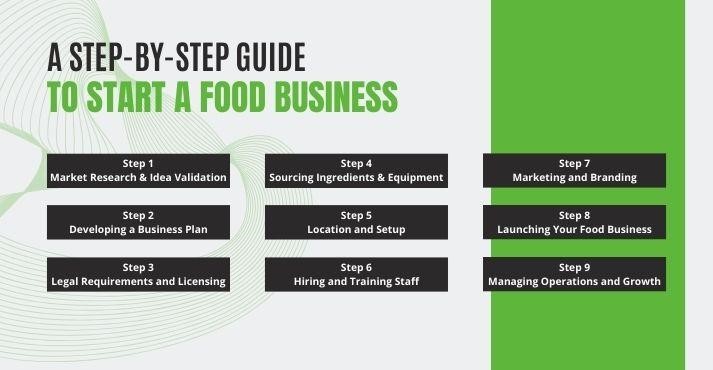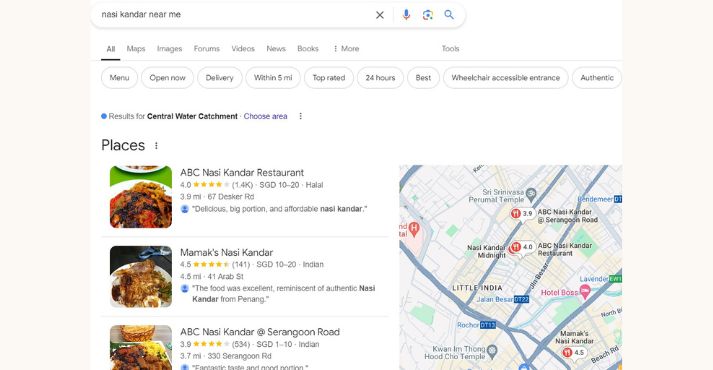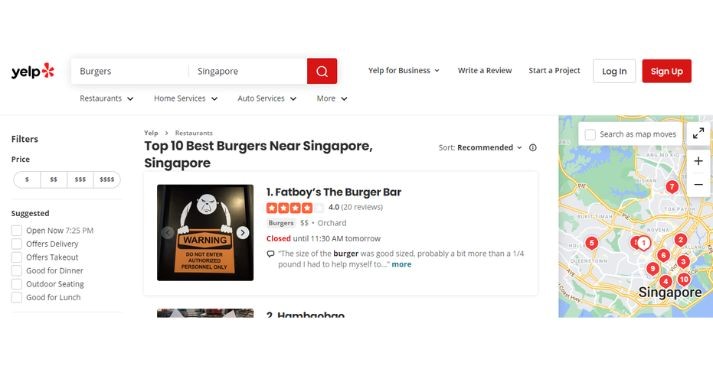According to Statista, Southeast Asia’s food and drink industry is projected to reach US$28.60m by 2029.
Innovative business models, from cloud kitchens and delivery services to quick-service and full-service restaurants, drive competition in the food industry.
Now is the perfect time to consider starting your own food business.
However, aspiring entrepreneurs must be creative and strategic, carefully evaluating all opportunities before launching.
Success in the fast food industry depends on comprehensive market research and the ability to meet the needs of your target customers.
In this guide, we will provide you with a complete step-by-step framework on how to start a food business, including best practices, strategies, and tips at every stage.
Step 1 – Market Research and Idea Validation

While interest is the number one step in starting a business, research is essential before introducing it to the market.
It will help you determine whether your concept has a place in the market and can attract customers. It will also allow you to analyze trends, consumer preferences, and competition.
For example, if you discover a growing demand for vegan food in your area but few providers, you may develop a menu catering to that need.
Create surveys or conduct interviews to gauge what types of food people are interested in. You can ask questions like:
- What are your favorite types of cuisines?
- How often do you order food or eat out?
- What dietary preferences or restrictions do you follow?
Moreover, look at local and online food businesses that are similar to your concept. Check their pricing, customer feedback, and marketing strategies.

Google Trends results for a specific search query
You can easily analyze the user search trends utilizing Google Trends and measure search interests in a particular food item, in a particular place, and for a particular time.
Once you gather information from your market research, it’s time to validate your business idea.
This step involves testing whether your concept resonates with potential customers.
Consider the following steps:
- Create a Minimum Viable Product (MVP): An MVP could be a simplified version of your menu or service for food businesses. You can offer samples at a local farmer’s market or host a pop-up event.
- Pre-Sell Your Product: If you plan on offering a subscription meal service or catering, consider pre-selling to gauge interest. For example, advertise on social media and see how many people sign up before you officially launch.
- Collect Feedback: Engage with your audience to gather feedback on taste, pricing, and packaging. This helps refine your concept before making a full commitment.
Once you’ve conducted the market research and validated your idea, you’ll need to decide your business model and financial planning.
Step 2: Developing a Business Plan
Do you dream of opening a vegan food truck or starting a farm-to-table pop-up restaurant?
When developing a business plan, also consider the following questions:
- What type of service do you want to offer?
- What does your target audience look like?
- What is your unique brand?
Your business model defines the way you operate and generate revenue.
The right model depends on factors such as startup capital, market demand, and personal preferences.
Here are some common food business models to consider:
1. Restaurant – A sit-down establishment
A restaurant is a traditional sit-down establishment where customers dine in and enjoy a curated meal in a controlled atmosphere.
This model allows business owners to offer an extensive menu, providing a variety of dishes that cater to different preferences.
Direct interaction with customers enhances the experience, allowing for personalized service, adjustments based on customer feedback, and a memorable dining ambiance.
However, restaurants typically come with high upfront costs, including renting a space, purchasing equipment, and hiring staff.
2. Food Truck – A flexible choice
One of the main advantages of this model is the lower startup cost compared to a brick-and-mortar restaurant.
Food trucks offer the flexibility to test different markets and adjust locations based on customer demand.
However, the kitchen space is limited, which can restrict menu options, and food trucks are often dependent on good weather and parking availability.
3. Online Delivery Service – The most convenient option
Orders are typically placed through a website or third-party app, making it convenient for people to enjoy meals from the comfort of their own homes.
The main benefit of this model is the reduced overhead costs associated with rent and utilities, and it offers the potential to serve a larger geographic area.
However, competition in the online food delivery space is high, and businesses must rely on third-party platforms, which may take a portion of the revenue.
4. Catering Business
A catering business offers flexibility, as it can be event-based, allowing the owner to work on a schedule that aligns with their capacity.
Catering services often work on large contracts and have the opportunity to specialize in a specific culinary niche.
However, the income can fluctuate based on the season or demand, and the business must be adaptable to different client needs and event settings.
5. Meal Subscription Service
A meal subscription model generates predictable revenue through consistent customer subscriptions and allows for tailored meal plans that cater to specific dietary preferences, such as gluten-free, keto, or vegan.
However, this business requires a well-organized packaging, shipping, and food quality logistics system to ensure efficiency and maintain standards.
The exact details of your plan will depend on what type of food business you’re looking to open.
Now that you’ve decided on your business model, you must define your unique value proposition (UVP).
Your unique value proposition explains why customers should choose your food business over competitors.
More importantly, it highlights what makes your business stand out, whether through the quality of your ingredients, the convenience you offer, or the experience you create.
To create a strong UVP, consider the following:
- Target Audience: Who are your ideal customers? Are they health-conscious individuals, busy professionals, or families? Define their needs and pain points to craft a message that resonates with them.
- Key Benefits: What is your business’s main benefit? It could be convenience, quality, affordability, or a unique culinary experience.
- Differentiation: What sets you apart from the competition? It could be your ingredients, menu, pricing model, or a special cooking technique.
Choose the model that aligns with your vision, resources, and customer preferences.
Once you’ve defined your business model, share your UVP with potential customers and gather feedback to ensure it resonates and differentiates you from competitors.
As you finalize your concept, it’s equally important to focus on creating a financial plan, which is essential for ensuring the success and sustainability of your food business.
A financial plan helps you understand your startup costs, such as rent, equipment, and licenses, which are crucial to avoid overspending early on.
Moreover, identifying funding sources—whether through personal savings, loans, or investors—is key to securing the capital needed to cover initial expenses and support growth.
There are several ways to secure funding for your new venture:
- Apply for a business loan
- Seek support from family and friends
- Bring in outside investors or a business partner
- Explore venture capitalists and angel investors
- Leverage crowdfunding platforms
- Apply for government grants or assistance programs
In addition to startup costs, revenue projections estimate your income over time, allowing you to plan for profitability and manage cash flow effectively.
Step 3: Legal Requirements and Licensing
Before launching your food business, it’s important to ensure you meet all legal requirements and obtain the necessary licenses to operate in Singapore and Southeast Asia.
Compliance with local regulations protects your business from legal issues and builds customer trust, essential for long-term success.
Licensing and Permits
In Singapore and other Southeast Asian countries, specific licenses and permits are mandatory to operate a food business.
These typically include the following:
- Food Hygiene Certification: In Singapore, all food handlers must obtain a Food Hygiene Certificate by attending a basic food hygiene course. This certification ensures employees understand safe food handling practices, which is critical to maintaining hygiene standards.
- Business Registration: Register your business with Singapore’s Accounting and Corporate Regulatory Authority (ACRA). Similarly, other Southeast Asian countries require business registration with their respective agencies.
- Food Shop License: Issued by Singapore’s National Environment Agency (NEA), this license is required to operate any premises where food is prepared, cooked, or sold.
- Halal Certification: If you’re targeting a Muslim customer base, applying for halal certification may be essential, especially in markets like Malaysia and Indonesia.
Health and Safety Regulations
Adhering to health and safety regulations is a top priority for any food business.
In particular, Singapore’s NEA outlines strict guidelines to maintain high food hygiene standards.
These include:
- Safe Food Storage: Ensuring proper food storage at recommended temperatures to prevent contamination is essential to avoid foodborne illnesses.
- Cleanliness of Premises: Maintaining clean kitchen and dining areas and regularly sanitizing is key to providing a healthy environment for customers.
- Employee Health Checks: Food handlers should undergo routine health screenings to ensure they are free of contagious diseases, further safeguarding your customers’ health.
Following these regulations, you protect your customers and help avoid fines, penalties, or even business closures due to violations.
Step 4: Sourcing Ingredients and Equipment
Restaurants need a lot of equipment to operate.
Thus, finding reliable suppliers is key to running a successful food business.
Therefore, to identify and partner with reputable suppliers for ingredients and kitchen equipment, start by researching vendors with a proven track record in quality and consistency.
Also, you must prioritize local suppliers to support the community and ensure fresher products while considering sustainable options to align with eco-conscious trends.
Establish clear communication and build long-term relationships with suppliers to ensure timely deliveries and negotiate better pricing.
Focus on durable, high-quality equipment that can withstand the demands of your kitchen while maximizing efficiency.
Here’s a list of essential kitchen equipment needed for different types of food businesses:
- Commercial Range and Oven: For versatile cooking needs.
- Deep Fryer: Essential for frying foods.
- Refrigeration Units: Includes reach-in refrigerators and walk-in coolers.
- Dishwasher: This is for efficient cleaning of dishes and utensils.
- Food Prep Tables: For organized food preparation.
- Microwave Oven: This is for quick reheating and cooking.
- Commercial Blender: For smoothies, soups, and sauces.
- Food Processor: For chopping, slicing, and mixing.
- Compact Cooking Range: Space-saving for smaller operations.
- Portable Deep Fryer: Suitable for mobile or compact setups.
- Under-Counter Refrigeration: Space-efficient storage.
- Portable Sink: This is for handwashing and dish cleaning in mobile setups.
- Heat Lamps: To keep food warm during service.
- Packaging Supplies: Containers and sealing equipment for delivery.
- Labeling Equipment: Labeling meal containers with ingredients and dates.
- Delivery Bags: Insulated to maintain food temperature during transport.
- Safety Equipment: Fire extinguisher and first aid kit for emergencies.
There will also be costs like plates, silverware, glassware, linens and towels, menus, and technology like your POS and payroll systems.
Step 5: Location and Setup
The location of your food business plays a key role in determining visibility, accessibility, and customer attraction.
Several factors must be considered to ensure the site meets your operational needs and attracts your target customers. Such as:
1. Foot Traffic
High foot traffic areas, such as busy streets, shopping districts, or near offices, can increase visibility and attract more customers.
Analyzing foot traffic patterns helps determine if the location aligns with your business model and customer base.
For example, a quick-service restaurant benefits greatly from being in a high-traffic area where people seek convenient meal options.
2. Competition
Assess the level of competition in the area.
Being close to competitors might be beneficial if you’re in a well-established food hub where customers expect to find various dining options.
However, too much competition could dilute your market share.
Therefore, researching existing businesses helps you measure whether the location will support your unique offerings or if you need to choose a less saturated area.
3. Accessibility
Consider factors like parking availability, public transportation options, and delivery access.
A location that is hard to reach or lacks sufficient parking can deter potential customers and complicate logistics.
4. Visibility and Signage
High visibility ensures that passersby notice your establishment, which is especially important for attracting new customers.
5. Cost
A prime location might have a higher price tag but can drive greater traffic and sales. Hence, balancing location costs with potential revenue is key to making an informed decision.
For example, a fine-dining Italian restaurant would thrive in an upscale brick building adjacent to boutique shops.
At the same time, a food truck serving deli sandwiches and small bites would be better suited in a casual, mobile setting.
Once you finalize the location for your food business, here are some tips on designing a functional and aesthetically pleasing space:
- Design layouts that optimize workflow and make the best use of available space.
- Choose equipment and fixtures that are comfortable and reduce strain for staff.
- Use decor, lighting, and color schemes that reflect your brand and create a pleasant environment for customers.
- Combine ambient, task, and accent lighting to enhance functionality and ambiance.
- Select durable, easy-to-clean materials for surfaces and flooring.
- Facilitate smooth movement between different areas, from the kitchen to the dining area.
- Address sound levels using materials that reduce noise and create a comfortable dining experience.
- Use design elements that reflect your brand’s personality, such as logos, colors, and themes.
- Use shelving, cabinets, and drawers to manage supplies and equipment efficiently.
- Include proper ventilation, sanitation stations, and easy access to emergency exits.
While many elements must be considered when designing a restaurant, you must balance style and function while keeping up with the latest trends.
Step 6: Hiring and Training Staff
The first step in building a strong team for your food business is defining clear job descriptions for each role, such as chefs, kitchen staff, and front-of-house employees.
Once you’ve established these roles, utilize multiple recruitment channels to reach a broad pool of candidates, including job boards, social media, and industry-specific forums.
In addition, focus on networks within industry circles, including food and beverage fairs, to connect with potential hires.
Furthermore, consider offering incentives or referral bonuses to attract skilled professionals and ensure a good fit for your business.
Once you’ve recruited your team, providing comprehensive training is important.
Here’s why it will help your staff:
- Food Safety: Prevents contamination and ensures compliance with health regulations.
- Customer Service: Enhances customer satisfaction and fosters repeat business.
- Brand Values: Aligns staff with your business’s mission and creates a unified experience for customers.
By investing in training, you enhance your team’s skills and contribute to the success and reputation of your food business.
Step 7: Marketing and Branding
Getting started with marketing doesn’t have to be expensive.
To begin, craft clear brand messaging that communicates your mission, vision, and what makes you unique.
Next, highlight your unique selling points (USPs), such as exceptional quality, sustainability, or convenience, to stand out from competitors.
With that in mind, here’s what you need to consider when developing your food brand:
- Identify what your business stands for and how it will connect with your target audience.
- Design a simple, recognizable logo that reflects your brand’s personality and industry.
- Develop concise, consistent messaging communicating your mission, vision, and values.
- Emphasize what sets your business apart, such as quality, service, or innovation.
- Choose a color palette and fonts that align with your brand’s tone.
- Create a voice that resonates with your professional, friendly, or quirky audience.
- Share your brand’s journey and purpose to build a personal connection with customers.
- Use high-quality images, videos, and graphics that reflect your brand’s identity and enhance recognition.
There is no best way to market a restaurant; it depends on your category, audience, location, and more.
Even with a limited budget, many ways exist to get started and achieve strong results.
Here are a few ideas to get you started:
Establish Your Online Web Presence With SEO
Search Engine Optimization (SEO) is a powerful marketing tool that helps customers find your restaurant naturally through search engines.
First, focus on building a strong online presence by creating a website and optimizing it with popular keywords that search engines like.
A recent study shows that 46% of all Google searches seek local business information.
Hence, local SEO helps your restaurant appear in searches when people are looking for nearby places to eat.
One of the best ways to reach potential restaurant customers is by signing up for a Google Business Profile.

Local search results in Singapore
This is an example of how this tool helps you manage how your restaurant appears on Google Search and Maps.
When people search for your restaurant, they’ll see key details like photos, special offers, updates, and more, giving them a complete snapshot of your business.
Get Listed on Dining Review Platforms
Listing your restaurant on dining review apps and platforms like Yelp or TripAdvisor can boost your visibility and attract more customers.
These platforms allow people to discover your business, read reviews, and share their dining experiences.
Also, these dining apps allow users to filter, so the key to these is adding as many details as possible, including:
- Category
- Website
- Address and phone
- Store hours
- Menu
- Price Range
- Photos, and lots of them
- Attributes: wifi, outdoor seating, parking, special diets, etc.

For example, searching for “burgers” in Singapore on Yelp will provide you with the following information.
Set Up Your Socials and Get Active
Setting up your social media profiles is the next step in building your online presence.
Here’s how you can benefit from social media marketing for your food business:
- Instagram: It is a great platform for sharing high-quality images and short videos of your food and restaurant, attracting a younger audience aged 18-34.
- TikTok: It is ideal for posting short, engaging videos about your menu, cooking tips, or dining experience. It is especially popular with users under 30.
- Facebook: It helps you reach a wide range of ages and is useful for sharing posts, photos, events, and reviews. It has a strong presence among adults 25-34.
- Twitter: It is best for quick updates, sharing news, and interacting with customers through brief messages.
For example, Hortus Singapore’s Instagram post below markets its venue by highlighting its refreshing ambiance with a captivating caption and appealing emojis.
This approach combines engaging visuals with direct messaging to drive customer action.

Source: Instagram
Step 8: Launching Your Food Business
Before jumping into daily service, consider a soft opening to test your food, systems, and processes.
A soft launch involves opening your food business to a limited audience before the official grand opening.
This approach provides valuable feedback on your operations, menu, and service, allowing you to adjust based on real customer experiences.
Addressing issues during the soft launch can improve the experience and ensure a smoother grand opening.
Here are some great ideas for launch events and promotional strategies to create buzz and attract customers:
- Host a VIP Preview Event: Invite local influencers and community leaders for an exclusive first look.
- Offer Limited-Time Discounts: Attract customers with special discounts or free samples during the opening week.
- Create Social Media Buzz: Run contests or giveaways leading up to the launch to generate excitement online.
- Collaborate with Local Businesses: Partner with nearby stores or brands for cross-promotional opportunities and joint events.
- Organize a Grand Opening Celebration: Plan a festive event with live music, food tastings, and entertainment to draw in crowds and create a memorable experience.
Once everything runs smoothly, you’re ready to open your business to the public.
Step 9: Managing Operations and Growth
Keeping your food business running smoothly is no easy task.
Therefore, careful planning, coordination, and implementation of strategies are required to ensure smooth operations, exceptional customer experiences, and profitability.
Here are some best practices you must consider for managing daily operations:
- Conduct frequent inventory counts to manage stock levels and avoid wastage.
- Train staff to deliver exceptional service and handle customer inquiries effectively.
- Use accounting software to monitor income, expenses, and profitability.
- Develop clear procedures for daily tasks to ensure consistency and efficiency.
- Track key performance indicators (KPIs) such as sales, customer satisfaction, and operational costs.
However, you will quickly realize that each day can vary, and routines may shift based on the season and business priorities.
They might focus primarily on a major goal most of the time while addressing the restaurant’s smaller needs as they arise.
There’s always room for improvement, so stay updated with your financials, actively seek and listen to feedback, and continuously look for growth opportunities.
With this in mind, you must closely monitor how you and your team manage the daily processes.
Moreover, here are some strategies that you can adopt to scale your food business:
- Expand to New Locations: Open additional outlets in different areas to reach a broader audience.
- Offer Catering Services: Provide catering for events to generate additional revenue and increase brand visibility.
- Introduce New Products: Add new menu items or products to attract more customers and keep your offerings fresh.
- Explore Franchising: License your business model to other entrepreneurs to expand your reach and brand.
- Invest in Technology: Implement advanced inventory, customer management, and sales tracking systems to support scalable growth.
Conclusion
You can start many types of food businesses, and competition can be intense.
Hence, our step-by-step guide on how to start a food business provides essential insights and practical tips to help you address the challenges and create a comprehensive plan for your venture.
With thorough market research and idea validation, you can define your business model and unique value proposition to set yourself apart.
Once you have a clear vision, address the legal requirements and licensing to ensure compliance and build a solid foundation.
Next, you must focus on sourcing quality ingredients and equipment to deliver exceptional products and services.
Moreover, choosing the right location and setting up a functional, inviting space will enhance your customer experience and operational efficiency.
As you move toward launching your business, consider a soft launch to gather feedback and make necessary adjustments before your grand opening. Effective marketing and branding strategies will help create buzz and attract customers to your new venture.
Once your business is up and running, managing daily operations diligently and planning for strategic growth will drive long-term success.
With careful planning and execution, your food business has the potential to thrive and become a cherished establishment within the community.













